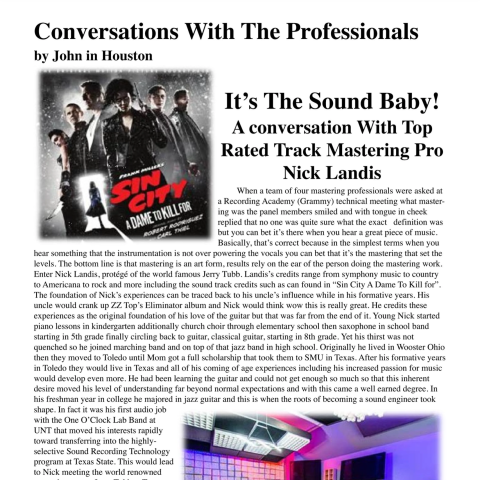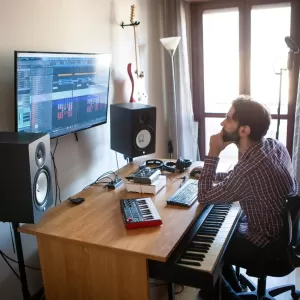
Originally published in the October 2023 issue of Rock and Blues International Magazine (pg. 46-47) as part of the Conversations With The Professionals series.
Conversations With The Professionals
by John in Houston
It’s The Sound Baby!
A conversation With Top Rated Track Mastering Pro Nick Landis
When a team of four mastering professionals were asked at a Recording Academy (Grammy) technical meeting what mastering was the panel members smiled and with tongue in cheek replied that no one was quite sure what the exact definition was but you can bet it’s there when you hear a great piece of music. Basically, that’s correct because in the simplest terms when you hear something that the instrumentation is not over powering the vocals you can bet that it’s the mastering that set the levels. The bottom line is that mastering is an art form, results rely on the ear of the person doing the mastering work. Enter Nick Landis, protégé of the world famous Jerry Tubb. Landis credits range from symphony music to country to Americana to rock and more including the sound track credits such as can found in “Sin City A Dame To Kill for”. The foundation of Nick’s experiences can be traced back to his uncle’s influence while in his formative years. His uncle would crank up ZZ Top’s Eliminator album and Nick would think wow this is really great. He credits these experiences as the original foundation of his love of the guitar but that was far from the end of it. Young Nick started piano lessons in kindergarten additionally church choir through elementary school then saxophone in school band starting in 5th grade finally circling back to guitar, classical guitar, starting in 8th grade. Yet his thirst was not quenched so he joined marching band and on top of that jazz band in high school. Originally he lived in Wooster Ohio then they moved to Toledo until Mom got a full scholarship that took them to SMU in Texas. While in Toledo the young upstart lived in the suburbs but it was here that he learned about original roots music, urban music. After his formative years in Toledo they would live in Texas and all of his coming of age experiences including his increased passion for music would develop even more. He had been learning the guitar and could not get enough so much so that this inherent desire moved his level of understanding far beyond normal expectations and with this came a well earned degree. In his freshman year in college he majored in jazz guitar and this is when the roots of becoming a sound engineer took shape. It didn’t take long before peers were telling him he was really good at it. In a short amount of time through his on the job sound duties he could handle multiple boards. This level of experiences led to Nick meeting Jerry Tubb the world renowned mastering expert at Terra Nova. Nick caught a break and was chosen to intern for the great master himself. Nick would go on to become a part of the Terra Nova team that was actively involved in the beta testing of the coveted Neve by Rupert Designs. Today, with these experiences behind him he is a revered expert on all phases of recording and mastering at his studio in Austin, Texas. His collection of studio projects shouts of a who’s who in music including Willie Nelson, Ruthie Foster, Dale Watson, Elaine Garcia, Jesse Dayton and more. But it doesn’t stop there, the man also gives credit where credit is due to other professionals on his website. For example, if another studio records the artist/band and he is contracted for mastering duties he lists their credits on his site as well as any others that could be mentioned. On another front the man continually educates those that are looking for industrial level support on rising technologies such as Dolby Atmos (he’s certified by Dolby). However, the education is not limited to new technologies but also encompasses existing technologies that many independent artists do not fully understand. A prime example is the topic of metadata. Without the proper metadata in place radio stations that spin the song cannot submit the spin to the chart tracking companies. Therefore the song is not going to chart even if it’s gaining strong radio play. Nick shares, “This happens way too often but it doesn’t have to happen. It’s a simple fix but it must be done before the product is submitted to radio. In this instance metadata (metadata tag) is in reference to what is known as the ISRC code (International Standard Recording Code). It’s a unique identifier much like that of a bar code. It’s easy to place when mastering but without it preferred results on the business side are limited. When it comes to wav submissions it has its own tag as well but the letters ISRC are not capitalized in this instance and it does make a difference. Then there is an identifier tag known as IPI for publisher rights. The end result is that these tags properly identify legal credits that are used by BMI and ASCAP.” At times artists wonder why a song seems to be doing good but no money is coming their way. Could it be it’s the improper listing of the metadata or possibly there isn’t any tag at all. You can read more about this on Nick’s blog which is located on his website. Plus, articles about all sorts of popular technical topics that effect good sound and proper submission can be found there too. You can learn more at Mastering | Nick Landis

